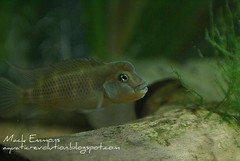Humphead Cichlid
Scientific Name(s): Steatocranus casuarius
General Care: A relatively peaceful species, the Buffalohead cichlid is a suitable for a community tank containing fish of similar size and temperament. This species is very curious and intelligent, each fish having an amusing personality. Endemic to fast flowing rivers, S. casuarius prefers an aquarium with a plenty of current. The aquarium should also feature a a fair amount of rockwork.
Minimum Tank Size: A 20 gallon tank would be a suitable size for a pair of these fish.
Description: S. casuarius sports a greyish brown color, with light brown broken vertical bars, and the same light brown outlining the scales. May also develope a blue metallic color with age. Also with age, males begin to develop a humped head.
Distribution: Congo River and its tributaries, West Africa.
Diet: Being an omnivore, these fish will thrive on a diet that features both meaty foods and also plant life. A balanced diet will give this species what it needs to thrive and do well.
Water Parameters: pH - 6.0/8.0
Temperature - 75/85 F (24/30 C)
Size: Males reach about 6 inches while females reach about 4 inches.
Water Region: Mid to lower reaches of the water column.
Sexing: Males are generally larger, sport a larger hump on their heads, and generally have longer finnage.
Breeding: The male and the female will dig a cave under a rock or similar structure in preparation for breeding. The female will lay the eggs in the cave, typically on the roof and sides. The eggs hatch after about 3 or 4 days, and the fry become free-swimming after about 5 days. In most cases, both parents will participate in guarding the fry. The fry are typically very large, similar to the size of the fry from mouthbrooders. Once a pair forms, it will remain for life, staying loyal to each other. The loss of one could mean the loss of the other.
Photos:

Young male Steatocranus casuarius.

Male S. casuarius. Notice the large hump on the forehead.


